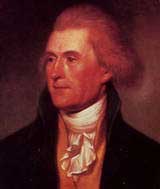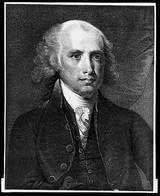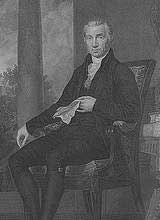
FGF E-Package
The Confederate Lawyer
July 7, 2011
The Golden Age of American Diplomacy
by Charles G. Mills
fitzgerald griffin foundation
GLEN COVE, NY — Virginia Republicans occupied the White House from 1801 to 1825, the golden age of American diplomacy. During that time, the United States grew from a small nation to the dominant power in the Western Hemisphere.
Thomas Jefferson, third
President of the United States, was in office from 1801 to 1809When Thomas Jefferson became President in 1801, imperial powers hemmed in the United States on three sides. To the north were the British Colonies of Upper Canada and Lower Canada. To the south were the Spanish colonies of East Florida and West Florida. On the west bank of the Mississippi River was the French colony of Louisiana.
At the end of the French and Indian War, Britain acquired Canada (then called “Quebec”) and all of Louisiana, except New Orleans and a small surrounding area, from France. About the same time, Britain also acquired Florida from Spain (along with additional French territory). The acquisition divided Florida into East Florida (approximately the present state of Florida) and West Florida along the Gulf Coast of Alabama, Mississippi, and Louisiana. In 1783, Spain acquired both Floridas from Britain; in 1800, France acquired Louisiana from Spain.
One of the first challenges facing Jefferson was the need to ensure access for American commerce on the Mississippi River and the Gulf of Mexico. Spain had interfered with this right during the administration of John Adams and in violation of a treaty with the United States. Jefferson offered to buy a piece of the Gulf Coast from France. France responded by offering to sell all of Louisiana to the United States.
The sale, which was completed in 1803, gave the United States a vast new territory, control of both banks of the Mississippi River, and a major port city on the Gulf of Mexico. Ohio was admitted to the Union in the same year, joining Kentucky and Tennessee as states and furthering the westward expansion of the nation.
As great as Jefferson’s accomplishment was, diplomatic challenges remained. Indians in parts of the Northwest Territory (especially today’s Indiana, Illinois, Michigan, and Wisconsin) waged war against American settlers with arms supplied by the British and Canadians. The Indians in the other western territory, Mississippi, were at times hostile. The British maintained illegal forts in the Northwest Territory and seized American seamen from American ships on the slightest suspicion that they were British born. The United States fought skirmishes with the Spanish over the border between Louisiana and West Florida.
James Madison, fourth
president of the United States,
was in office from 1809 to 1817James Madison inherited these problems in 1809. He had an opportunity to deal with the Florida border problem the following year when the people of West Florida declared their independence from Spain. The United States soon annexed West Florida, providing a port at Mobile in addition to one at New Orleans, and a long Gulf coastline. In 1812, Louisiana was admitted to the Union, confirming Madison’s expansionist policy to the South and West.
Madison had with an opportunity to deal with the Indian problem in the Northwest Territory. A de facto war was being waged between the tribes following Tecumseh, aided and supplied by British and Canadians, and the United States. In 1812, Madison asked for and got a declaration of war against Britain. The United States had only a handful of frigates; the British had over 1,000 ships of the line in addition to hundreds of smaller vessels. Madison’s plan accordingly was for a land war. Ironically, some of our greatest naval victories were won on the Great Lakes. Contemporaries understood that the war was waged for the survival of the United States as an independent and respected nation. Francis Scott Key described the British goal as one that sought to “leave us a home and a country no more.” The subsequent Canadian myth that the United States wanted to annex Canada was absurd. The South and New England were both overwhelmingly against such annexation, making it politically unfeasible.
Although the United States won key battles in the war overall, neither side had a true military victory. The eventual peace terms, however, constituted a great American victory. The terms recognized American sovereignty over all its territories, ended the presence of British forts in the United States, and -- without expressly saying so -- ended the British and Canadian practices of arming American Indians and paying them for American scalps. Although the British refused to give up the right to kidnap allegedly British sailors, they stopped the practice.
James Monroe, fifth
president of the United States, was in office from 1817 to 1825James Monroe became the third consecutive President from Virginia in 1817. His major diplomatic problem was Florida, a Spanish colony without the former West Florida. Thinly populated by the Spanish, it also had a British Tory population that was Catholic and nominally loyal to the king of Spain. There was one British fort without British troops that was manned by Indians and escaped slaves. American troops entered Florida to destroy the British fort. The sentiment in America was that the Spanish were failing in their duty to colonize Florida. Border skirmishes ensued. Finally, in 1819, Spain sold Florida to the United States. By diplomacy, the three Virginian presidents had eliminated the threats to the United States on all three fronts.
Monroe’s final diplomatic triumph came in his seventh annual State of the Union message in 1823, in which he proclaimed the Monroe Doctrine. This doctrine stated that the United States would consider any European attempt to colonize any part of the Americas as an act of war. It further held that any attempt to colonize any former colony that had won its independence would also be considered an act of war. The United States agreed not to become involved in internal European conflicts.
In less than a quarter of a century, the United States progressed from an endangered nation to the undisputed American power under three consecutive Virginia presidents. The Monroe Doctrine served the United States well for almost a century until Woodrow Wilson involved the nation in World War I.
Monroe’s second term ended in 1825. He was followed by his Secretary of State, John Quincy Adams, one of the negotiators of the treaty that ended the War of 1812 and the main draftsman of the Monroe Doctrine. Never again would we see a period of such unbroken diplomatic success.
The Confederate Lawyer archives
The Confederate Lawyer column is copyright © 2011 by Charles G. Mills and the Fitzgerald Griffin Foundation, www.fgfBooks.com. All rights reserved.
Charles G. Mills is the Judge Advocate or general counsel for the New York State American Legion. He has forty years of experience in many trial and appellate courts and has published several articles about the law.
See his biographical sketch and additional columns here.
To sponsor the FGF E-Package, please send a tax-deductible donation to the:
Fitzgerald Griffin Foundation
344 Maple Avenue West, #281
Vienna, VA 22180
1-877-726-0058
publishing@fgfbooks.com
or donate online.
@ 2025 Fitzgerald Griffin Foundation


